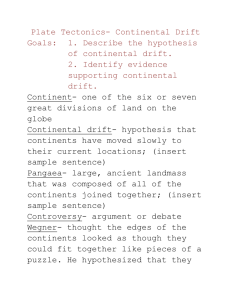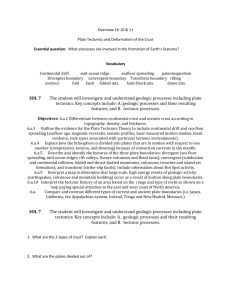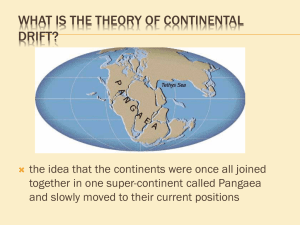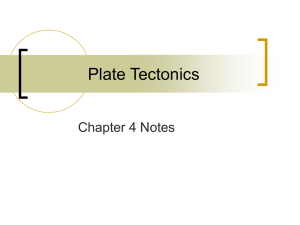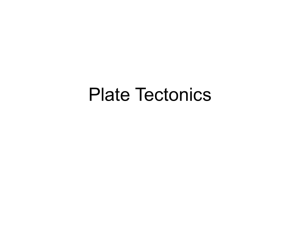Plate Tectonics Study Guide (Ch. 4)
advertisement
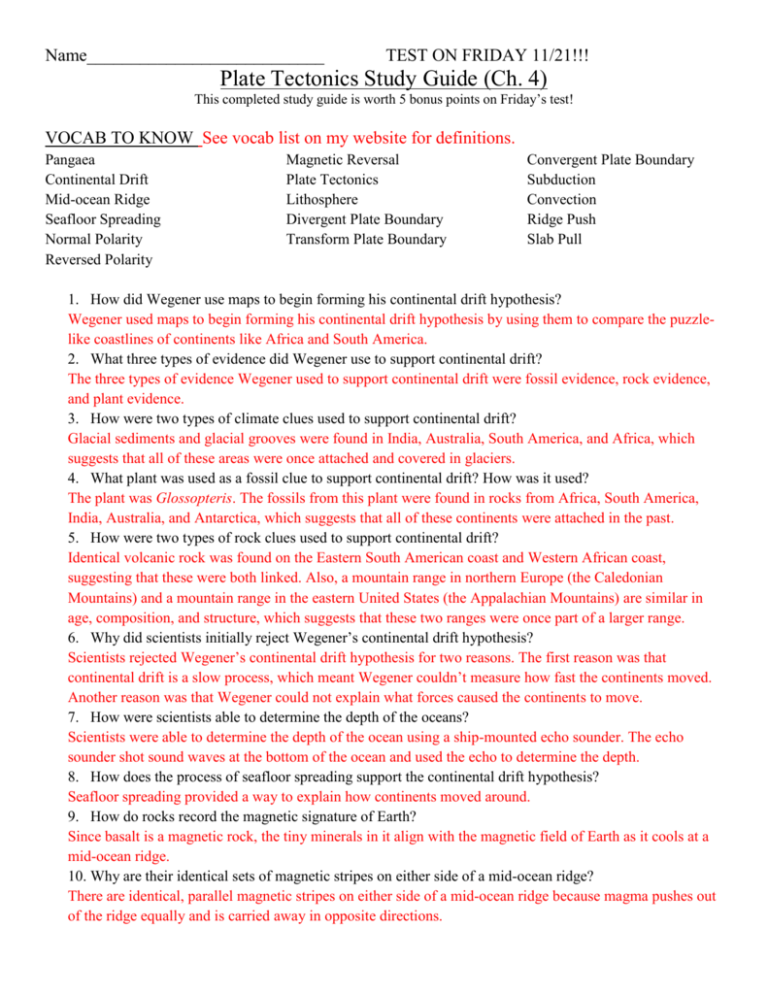
Name___________________________ TEST ON FRIDAY 11/21!!! Plate Tectonics Study Guide (Ch. 4) This completed study guide is worth 5 bonus points on Friday’s test! VOCAB TO KNOW See vocab list on my website for definitions. Pangaea Continental Drift Mid-ocean Ridge Seafloor Spreading Normal Polarity Reversed Polarity Magnetic Reversal Plate Tectonics Lithosphere Divergent Plate Boundary Transform Plate Boundary Convergent Plate Boundary Subduction Convection Ridge Push Slab Pull 1. How did Wegener use maps to begin forming his continental drift hypothesis? Wegener used maps to begin forming his continental drift hypothesis by using them to compare the puzzlelike coastlines of continents like Africa and South America. 2. What three types of evidence did Wegener use to support continental drift? The three types of evidence Wegener used to support continental drift were fossil evidence, rock evidence, and plant evidence. 3. How were two types of climate clues used to support continental drift? Glacial sediments and glacial grooves were found in India, Australia, South America, and Africa, which suggests that all of these areas were once attached and covered in glaciers. 4. What plant was used as a fossil clue to support continental drift? How was it used? The plant was Glossopteris. The fossils from this plant were found in rocks from Africa, South America, India, Australia, and Antarctica, which suggests that all of these continents were attached in the past. 5. How were two types of rock clues used to support continental drift? Identical volcanic rock was found on the Eastern South American coast and Western African coast, suggesting that these were both linked. Also, a mountain range in northern Europe (the Caledonian Mountains) and a mountain range in the eastern United States (the Appalachian Mountains) are similar in age, composition, and structure, which suggests that these two ranges were once part of a larger range. 6. Why did scientists initially reject Wegener’s continental drift hypothesis? Scientists rejected Wegener’s continental drift hypothesis for two reasons. The first reason was that continental drift is a slow process, which meant Wegener couldn’t measure how fast the continents moved. Another reason was that Wegener could not explain what forces caused the continents to move. 7. How were scientists able to determine the depth of the oceans? Scientists were able to determine the depth of the ocean using a ship-mounted echo sounder. The echo sounder shot sound waves at the bottom of the ocean and used the echo to determine the depth. 8. How does the process of seafloor spreading support the continental drift hypothesis? Seafloor spreading provided a way to explain how continents moved around. 9. How do rocks record the magnetic signature of Earth? Since basalt is a magnetic rock, the tiny minerals in it align with the magnetic field of Earth as it cools at a mid-ocean ridge. 10. Why are their identical sets of magnetic stripes on either side of a mid-ocean ridge? There are identical, parallel magnetic stripes on either side of a mid-ocean ridge because magma pushes out of the ridge equally and is carried away in opposite directions. Name___________________________ TEST ON FRIDAY 11/21!!! 11. What are two other pieces of evidence that support seafloor spreading? One piece of evidence that supports seafloor spreading is that scientists have found that more thermal energy is released near mid-ocean ridges than below abyssal plains. Another piece of evidence that supports seafloor spreading is that sediments collected from the seafloor show that sediments closest to a mid-ocean ridge are younger than sediments farther away from the ridge. Sediment depth also increases with distance away from the mid-ocean ridge. 12. What parts of Earth are tectonic plates made of? Tectonic plates are made of the uppermost layer of mantle and the crust. This is also known as the lithosphere. 13. What layer of the Earth do tectonic plates “float” on? The tectonic plates float on the asthenosphere, which is a plastic layer of Earth that is slightly flowing. 14. Why do tectonic plates move? Tectonic plates move because of the convection currents in the mantle. 15. Why is the area around the Pacific Ocean called the “Ring of Fire”? The area around the Pacific Ocean is called the “Ring of Fire” because there are many volcanoes along the Pacific Plate. 16. Compare and contrast plate tectonics and continental drift. Plate tectonics and continental drift are similar because they both involve movement. Plate tectonics and continental drift are different because plate tectonics involve the movement of tectonic plates, while continental drift only involves the movement of continents. Also, the continental drift hypothesis does not explain why the continents move, but the plate tectonic theory does. Finally, one is a hypothesis and the other is a theory. 17. What forces cause plate motion? The forces causing plate motion are convection, basal drag, ridge push, and slab pull. 18. Which forces would you expect to see at a mid-ocean ridge? I would expect to see ridge push and basal drag at a mid-ocean ridge. 19. What is a subduction zone? A subduction zone is the area where an oceanic plate subducts, or sinks, below another plate. 20. Which force happens at a subduction zone? The force that happens at a subduction zone is slab pull. 21. Which plate boundary forms new crust? Divergent plate boundaries form new crust. 22. Which plate boundary may destroy crust? Convergent plate boundaries may destroy crust. 23. Which plate boundary neither creates nor destroys crust? Transform plate boundaries neither create nor destroy crust. 24. How does the theory of plate tectonics explain why earthquakes and volcanoes occur in certain places? Volcanoes and earthquakes typically appear in specific places according to what is going on with the tectonic plates in that area. Name___________________________ TEST ON FRIDAY 11/21!!! Draw and label each type of boundary- include types of plates, landform(s) created, and the direction of plates. Divergent- Oceanic Divergent- Continental Convergent-Ocean/Continent Convergent- Oceanic Convergent- Continental Transform Name___________________________ TEST ON FRIDAY 11/21!!! Convergent Transform 3 Oceanic/Continental Oceanic Continental An oceanic plate collides with An oceanic plate collides with A continental plate collides and subducts under a and subducts under another with crushes against a continental plate. oceanic plate. continental plate. One plate slides past another. Earthquakes, faulting Earthquakes, ocean trenches, Earthquakes, ocean trenches, Intense folding and faulting, lines of volcanoes, chains of volcanic islands, broad mountain ranges, shallow destruction of oceanic lithosp. destruction of oceanic lithosp. earthquakes, short/thick plates San Andreas Fault Washington/Oregon St. Lucia or Himalaya Mountains or coastline Martinique Appalachian Mountains. Name___________________________ TEST ON FRIDAY 11/21!!! Divergent Convection 2 Oceanic Circulation of molten rock within the mantle Continental Basal Drag Two oceanic plates move Two continental plates move Produced by convection away from each other. away from each other. currents in the mantle, drags the lithosphere with it. Ridge Push Caused by rising mantle at mid- Submarine mountain ranges, Rift valleys, long linear lakes ocean ridges. Pushes lithosphere seafloor spreading, volcanic or seas, faults, earthquakes, in opposite directions. activity, shallow earthquakes volcanic activity Slab Pull At a subduction zone, as a slab Mid-Atlantic Ridge (plate) sinks, it pulls on the rest East Africa Rift Valley of the slab.



